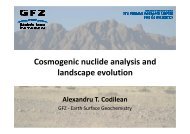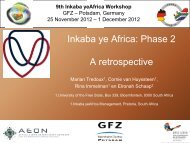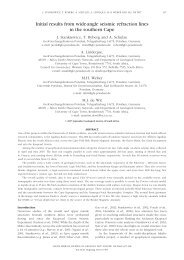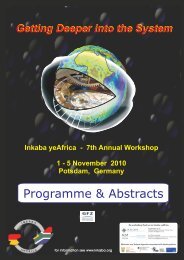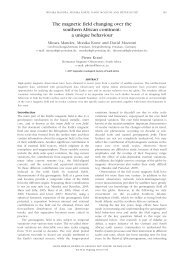South Africa - Inkaba.org
South Africa - Inkaba.org
South Africa - Inkaba.org
Create successful ePaper yourself
Turn your PDF publications into a flip-book with our unique Google optimized e-Paper software.
Mineralogical, geochemical and structural characteristics of<br />
quartz-arenites of the middle Witteberg Group (Cape<br />
Supergroup) near Kirkwood, Eastern Cape, <strong>South</strong> <strong>Africa</strong><br />
Wernich C. Olivier 1 , P.W.K. Booth 2 , C.R. Anderson 3<br />
1. Nelson Mandela Metropolitan University, <strong>South</strong> <strong>Africa</strong>, wcolie4@gmail.com<br />
2. Nelson Mandela Metropolitan University, <strong>South</strong> <strong>Africa</strong>, peter.booth@nmmu.ac.za<br />
3. Nelson Mandela Metropolitan University, <strong>South</strong> <strong>Africa</strong>, Callum.anderson@nmmu.ac.za<br />
ABSTRACT<br />
A study of Late Palaeozoic Witteberg Group rocks (Cape Supergroup) near Kirkwood, Eastern Cape was carried<br />
out to determine the viability of extracting silica for solar cell production. Mineralogical, geochemical and<br />
structural analyses of selected outcrops of quartz-arenites showed that source rocks in the study area do not possess<br />
the appropriate chemical attributes to warrant extraction of silica. Despite this finding the study presents valuable<br />
information on strata composition and structural data which are compared and interpreted with known regional<br />
structural patterns of the Cape Fold Belt in the Eastern Cape.<br />
Samples from the Witpoort Formation were analyzed using petrographic light microscopy, scanning electron<br />
microscopy and X-ray fluorescent spectroscopy. Analyses indicate that samples are composed almost entirely of<br />
quartz, with accessory biotite, muscovite, sericite, baryte, apatite, rutile and monazite. Haematite occurs most<br />
frequently along fractures, and is more prevalent in the Rooirand Member than the Perdepoort member, giving the<br />
former a reddish brown colour on outcrop. The presence of chemical impurities is thought to be partly controlled<br />
by the original depositional environment, namely, near-shore and beach environments. However, certain<br />
impurities, especially Fe, were most probably emplaced during episodes of faulting related to the Cape Orogeny.<br />
Rocks in the study area display a range of fold styles, mostly showing northward vergence. Low angle thrust faults<br />
dip south and some thrusts dip north. In general, the orientation of fore-thrusts and folds in the study area indicate a<br />
northward-directed compression event during the Late Palaeozoic. This pattern conforms to the structural<br />
development in other parts of the Cape Fold Belt in the Eastern Cape. The south-dipping normal faults and strikeslip<br />
faults that formed during the Mesozoic break-up of Gondwana transect all other structures in the study area.<br />
KEYWORDS: Cape Fold Belt, deformation, silica.<br />
66



